Is your classroom overflowing with stuff? Are you holding onto random materials and supplies “just in case” you need them one day? In this episode, you’ll hear how I was once forced to pare down my classroom to the most essential items, and the incredibly impact that had on my teaching. You’ll learn strategies for deciding what to keep and what to toss out, and how to be more selective about the materials you allow into your classroom.
This post is based on the latest episode of my weekly podcast, Angela Watson’s Truth for Teachers. A podcast is essentially a talk radio show that you can listen to online or download and take with you wherever you go. I release a new episode each Sunday and feature it here on the blog to help you get energized and motivated for the week ahead. Learn more about the podcast, view blog posts for all past episodes, or subscribe in iTunesto get new episodes right away.
Thank you, GoNoodle, for sponsoring this episode. GoNoodle is a free website with interactive videos and games to help kids focus during the school day! I love GoNoodle because it makes it super easy for teachers to find the energizing OR calming breaks students need to stay engaged. Teachers can sign up for free at GoNoodle.com.
Want to listen instead of read?
Listen to episode 16 below,
or subscribe in your podcast app.
So today is the first episode of the new Ask Angela Anything format I’m trying out. The question I’m answering today comes from Emily, who went to TruthForTeachers.com and filled out the anonymous Google form there to ask the following question:
“Angela, my classroom is overflowing with stuff. I never want to get rid of anything because I’m afraid I’ll need it one day. How do I know what to keep and what to throw away?”
Emily is far from the only teacher dealing with this issue. Many of us, by nature, tend to be hoarders. We hold onto everything, just in case. We develop this mindset of scarcity, because we never know what we’re going to have from one minute to the next. We never know if the school is going to cut the budget for pencils or paper, or if materials are going to come up missing or get destroyed. And many of us as teachers are very creative people: something might look like junk to someone else, but we see all these possibilities for ways it could be used in the classroom.
I’ll tell you my story. Personally, I didn’t struggle with classroom clutter as much as classroom hoarding. I remember as a first-year teacher, I used to eat frozen meals for my lunch a lot. They were something that I didn’t have to think about or pack the night before, they could be ready in two minutes, and then I could eat them in another three minutes. Sure, they taste pretty disgusting, but whatever. And I remember scrubbing out the little plastic containers each time and taking them home to run through the dishwasher because I felt guilty throwing them away. I thought, Oh, I can use them for center materials, or to hold math manipulatives, or office supplies. These are perfectly good containers. I was eating those meals pretty much every day, there was certainly no shortage of them. And yet I felt compelled to hang onto them. There were stacks of them in the cabinet under the classroom sink, and stacks of all these other things I was keeping in all the other cabinets.
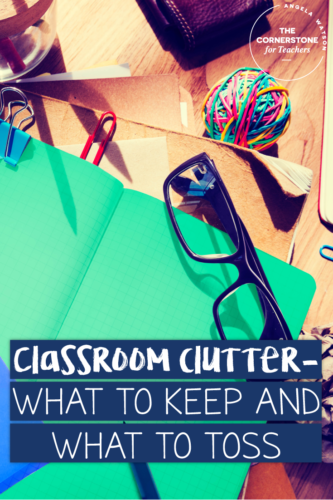
When I changed grade levels, I had to transfer schools, and that’s when I realized how much stuff I had really accumulated with this “just in case” mentality. So I stopped saving the plastic containers, and I got rid of a lot of things. But I still held onto way too much stuff. It wasn’t until my 6th year of teaching when I moved from Washington DC to Miami and suddenly I couldn’t just U-Haul things over from one school to another, and I had to pay movers to bring things from my old classroom to my new classroom, that I really had to take a good look at my habits. I was slightly horrified to realize how much stuff I had: bookshelves, boardgames, hundreds of children’s books, countless papers, the list just went on and on.
It absolutely killed me, but I left behind my beautiful vintage 50s mod couch that my grandmother had given me. I had to. I just could not keep dragging all this stuff around. Trust me, it hurt. But I knew my new classroom was going to be much smaller, and I really needed to pare down. And it’s not like it was going in the garbage. This was stuff that was going to continue to be used by kids who needed it. The teacher who took over my classroom was thrilled – I’d taken about 50% of the stuff out the room and she still had more than enough books and supplies and furniture. Yikes – that alone tells you how much STUFF I had.
Then the situation got more painful for me. I had transferred in October to a school that was overcrowded, and a new building was under construction. It was supposed to be ready many months before I started, but you know how that goes with the budget cutbacks and construction delays. So when I started teaching, my room wasn’t ready and I had to share a classroom with another teacher. It was me and my 27 kids, and her and her 26 kids all in one classroom. And she was there first, in August, so she had dibs on all the cabinet space, and had already settled the kids into routines with her materials. So in addition to parting with at least 50% of my stuff, most of the remaining stuff had to go in storage because there was no place in the room. I had to figure out what was absolutely essential to my teaching and not depend on all those other materials that I had collected over the years “just in case.”
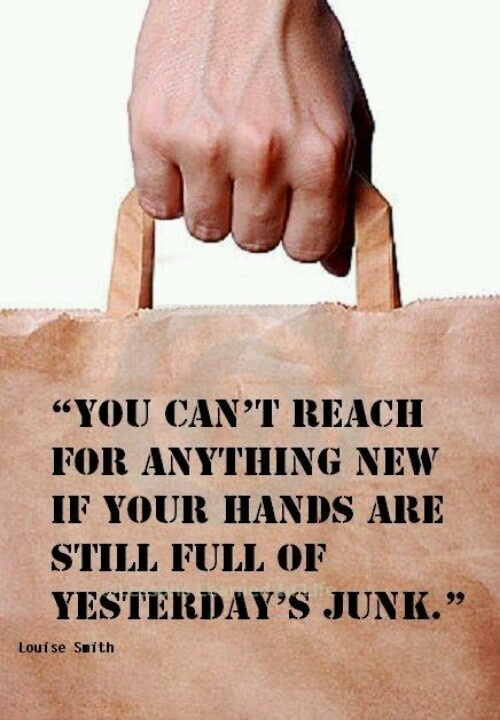
And it was that year when I realized how little I really needed in order to teach well. It was a game-changer for me. I learned to shift my approach from “Can I possibly use this someday?” to “How likely is it that I will NEED this one day in order to teach well? And if I really need this one day, will I be able to get it or something similar again?” That shift in questioning helped me let go of the compulsive need to hang onto everything.
So, my advice to you if you feel like you are drowning in teaching materials, is to start TODAY with being more careful about what you allow to come into your classroom. Getting rid of stuff can be a tough and overwhelming process that you might not be ready for today, but you CAN start being more selective with what you bring into the classroom.
Stop keeping multiple copies of every paper you have. I used to keep at least 2 copies of the stuff I really loved in case I lost one or the photocopier chewed it up. But you only need one paper copy, if that, since you have the ability to keep digital copies of everything. I used to keep examples of student work as benchmarks and exemplars for future classes, but then one day I just scanned them or took photos or them and threw the hard copies away. That was a huge amount of stuff right there.
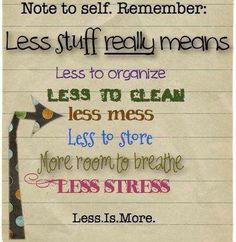
You can use free tools like Dropbox and Google Drive to organize your digital copies and sync them automatically to the cloud so that if your computer crashes, you don’t lose anything, and you can access your documents from any device, anywhere in the world. I got rid of so many papers once I got hooked on Dropbox. I started keeping digital folders for each teaching unit. I still had physical folder, but I was able to keep far fewer papers in them – just the stuff I knew I wanted to photocopy the following year for sure, and the “maybe” stuff I kept only in digital form.
The same thing goes for forms. If you’ve got a memo from your principal in your email, you don’t need a paper copy, too. It’s much easier to use the search function in your email to pull it up than to dig through a file cabinet.
So, starting today, take another step forward toward going paperless, and be very selective about how many paper copies you keep and what items you allow into your classroom.
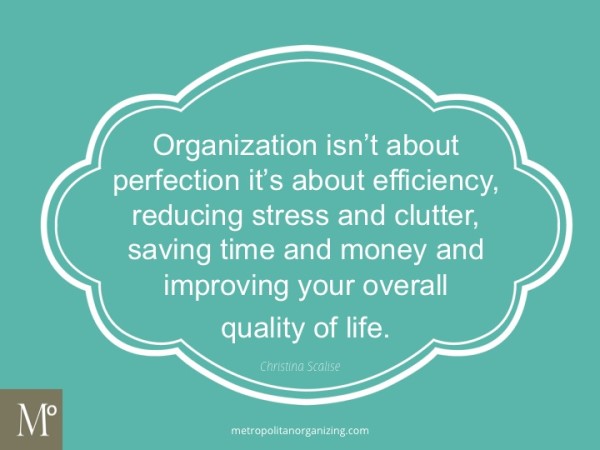
Now when it comes to cleaning out what you already have, there are two approaches you can take. One is to do a little bit at a time – maybe stay after school for 30 minutes a day and tackle it slowly. Another approach is to come in the week before or after school ends or over holiday break and just work yourself to the bone for a couple days and get it done. Personally I prefer that second approach – to just dedicate ONE day to cleaning and organizing and then all you have left is just maintaining it afterward.
If you don’t know where to start, I have a free PDF called Avoiding The Paper Trap, which is a seven-step system for organizing everything for in your classroom. If you want more information on how to organize your other teaching materials, including your lesson materials and the kids stuff, I’ve written extensively about that in my book, The Cornerstone: Classroom Management That Makes Teaching More Effective, Efficient, and Enjoyable. I share how to set up your classroom, how to do a spring cleaning, and even how to start from scratch if you have a completely empty room that you just moved into. If you don’t know what to throw away and what to keep, I’ve covered all of that in detail in the book.
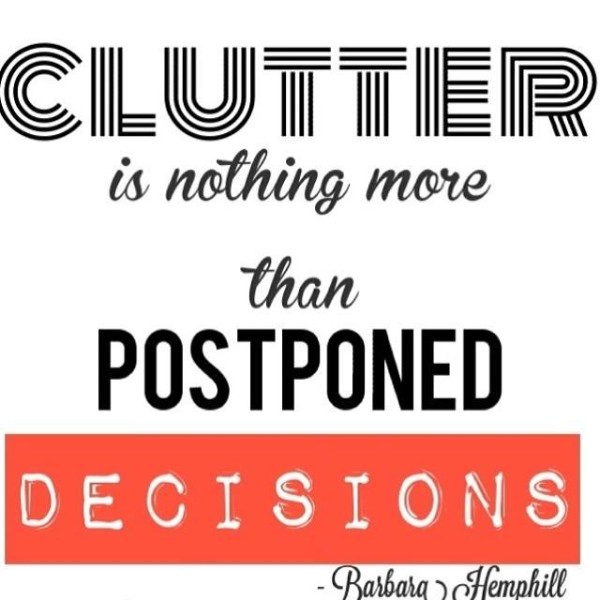
Just keep in mind that cleaning isn’t the the larger battle here. The most important aspect is not accumulating more things. I know many teachers who’ve spent hours and hours cleaning out and organizing their classrooms, and two months later, their rooms look exactly like they did before. If you keep accumulating new things, the problem is just gonna keep reoccurring.
When you’re tempted to keep something, remember that you can probably buy it, borrow it, or do without it later. And often that last option – to do without it – ends up being the best one.
Start paying attention to what materials you use the most in your classroom, and rely only on those. Chances are, you actually need very few things in order to do an amazing job with your students. Great teachers know how to make do, and you’re a great teacher. Trust your ability to think on your feet, improvise, and innovate. It’s not your STUFF that makes you amazing, it’s YOU.
Clutter is nothing more than postponed decisions.--Barbara Hemphill Click To TweetLet me know in the comments what your struggles are with clutter and classroom organization right now–I’d love to help you out! Or, click here if you have a question you’d like me to answer on the podcast.
![]() See blog posts/transcripts for all episodes
See blog posts/transcripts for all episodes
The Truth for Teachers Podcast
Our weekly audio podcast is one of the top K-12 broadcasts in the world, featuring our writers collective and tons of practical, energizing ideas. Support our work by subscribing in your favorite podcast app–everything is free!
Explore all podcast episodes
Angela Watson
Founder and Writer
Sign up to get new Truth for Teachers articles in your inbox
Discussion
Leave a Reply
OR

Join our
community
of educators
If you are a teacher who is interested in contributing to the Truth for Teachers website, please click here for more information.



















Hi Angela,
I became a teacher hoarder when I taughtt pre school, kindergarten grades 1, 2 & lastly grade 4. I had collected so much stuff I rented a storage unit. I stopped teaching 10 yrs ago. After 3 yrs of renting, I convinced my husband to put together metal shed in our yard. After some time, the shed started leaking. Finally I crammed stuff into my garage, basement, screen porch & extra room. I had hired an organizer & had a sale right in the halls of the rented unit. I was happy but still had lots left. I quit teaching because of a horrible principal I couldn’t deal with. This is one reason I can’t let go, I was only 50 at the time & hopeful about wanting to teach again. I started tutoring, teaching ESL & nannying. I couldn’t let go of the stuff. I think about all the $$$ I spent & 80% it was never used, especially children’s hard cover books! I know full well that’s a lame excuse & another is that my daughter plans to have a baby in next 2 yrs. So that’s my story, as a hoarder how do I let go? If I could just hand over much of it to a low income, struggling school or send to a country in crises. I am reeeeealing struggling here. The only positive thing I did last week was offer my beloved plush and I’m also puppets to my daughter visiting from Colorado where she recently became licensed as a therapist that includes troubled kids. I tried asking my decluttering group online but the comments still haven’t budged me. I want my house back & be happy to let go. Thanks for reading. Cindy
I totally understand–the books were the hardest thing for me. I kept a very large plastic tub of my favorite books (the ones I’d want to share with my kids/grandkids one day) and gave all the rest to a new teacher friend. She took the majority of my stuff, as a matter of fact. It made me feel good to know that all my things would go to good use–and they have!
I’m a music teacher and I was always told never to throw away any music. It’s too valuable as sometimes it goes out of print. My problem is I have a lot of old music I don’t use but don’t want to throw it away.
C
I understand the dilemma here. I guess my question is, “It’s too valuable to throw away…for whom?” Who would ever want or need it besides yourself?
If the answer is “no one,” then I think you can safely recycle it.
If there are some folks or organizations who would find it valuable, can you give or sell it to them now so it’s not taking up space in your classroom?